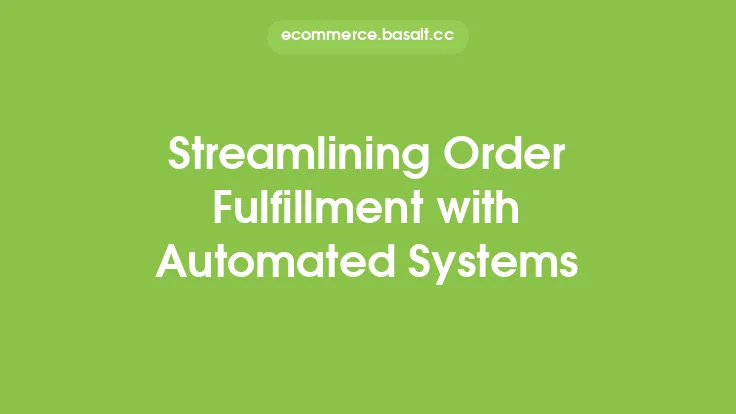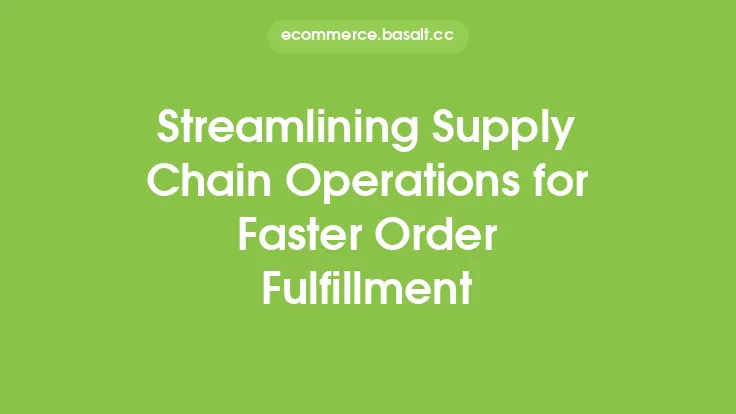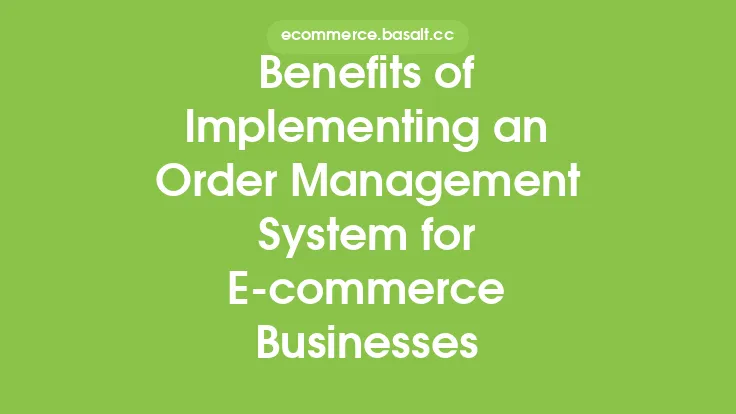The e-commerce industry has experienced rapid growth over the past decade, with more businesses shifting their operations online. As a result, the need for efficient order fulfillment has become a critical aspect of e-commerce success. Manual order management processes can be time-consuming, prone to errors, and often lead to delays in shipping and delivery. This is where automated order management comes into play, streamlining the entire process and enabling businesses to fulfill orders quickly and accurately.
Introduction to Automated Order Management
Automated order management refers to the use of technology and software to manage and fulfill customer orders. This process involves integrating various systems, including inventory management, shipping, and payment processing, to create a seamless and efficient order fulfillment experience. Automated order management systems use algorithms and business rules to automate tasks such as order routing, inventory allocation, and shipping carrier selection. By automating these tasks, businesses can reduce the risk of human error, increase processing speed, and improve overall customer satisfaction.
Benefits of Automated Order Management
The benefits of automated order management are numerous. For one, it enables businesses to process orders faster and more accurately, which leads to improved customer satisfaction and reduced returns. Automated order management also helps businesses to better manage their inventory, reducing stockouts and overstocking. Additionally, automated order management systems can provide real-time tracking and updates, enabling customers to stay informed about the status of their orders. This level of transparency and communication helps to build trust and loyalty with customers, leading to increased repeat business and positive word-of-mouth.
Key Components of Automated Order Management
There are several key components that make up an automated order management system. These include order capture and processing, inventory management, shipping and fulfillment, and payment processing. Order capture and processing involve the receipt and processing of customer orders, which can come from various channels such as e-commerce websites, mobile apps, or social media platforms. Inventory management involves tracking and managing stock levels, including automated alerts for low stock levels and inventory replenishment. Shipping and fulfillment involve selecting the most efficient shipping carrier and routing orders to the appropriate warehouse or fulfillment center. Payment processing involves securely processing customer payments and handling refunds and cancellations.
How Automated Order Management Works
Automated order management systems work by integrating with various e-commerce platforms, marketplaces, and third-party logistics providers. When a customer places an order, the automated order management system receives the order information and begins processing it. The system checks inventory levels, selects the most efficient shipping carrier, and routes the order to the appropriate warehouse or fulfillment center. The system also handles payment processing, including securely processing customer payments and handling refunds and cancellations. Throughout the process, the automated order management system provides real-time tracking and updates, enabling customers to stay informed about the status of their orders.
Best Practices for Implementing Automated Order Management
Implementing automated order management requires careful planning and execution. Businesses should start by assessing their current order management processes and identifying areas for improvement. They should also evaluate their technology infrastructure and determine whether they need to upgrade or replace existing systems. When selecting an automated order management system, businesses should consider factors such as scalability, flexibility, and integration with existing systems. They should also look for systems that provide real-time tracking and updates, as well as automated alerts and notifications. Finally, businesses should provide training and support to their staff to ensure a smooth transition to the new system.
Common Challenges and Solutions
Despite the benefits of automated order management, there are several common challenges that businesses may face when implementing these systems. One of the most significant challenges is integrating automated order management with existing systems, such as e-commerce platforms and inventory management systems. To overcome this challenge, businesses should look for systems that provide pre-built integrations and APIs for custom integrations. Another challenge is handling exceptions and errors, such as inventory discrepancies or shipping carrier issues. To overcome this challenge, businesses should look for systems that provide automated alerts and notifications, as well as workflows for handling exceptions and errors.
Future of Automated Order Management
The future of automated order management is exciting and rapidly evolving. One of the most significant trends is the use of artificial intelligence and machine learning to optimize order fulfillment. These technologies can help businesses to better predict demand, optimize inventory levels, and select the most efficient shipping carriers. Another trend is the use of cloud-based automated order management systems, which provide greater scalability and flexibility than on-premise systems. Finally, there is a growing trend towards omnichannel order management, which involves integrating automated order management with multiple sales channels, including e-commerce websites, mobile apps, and social media platforms.
Conclusion
In conclusion, automated order management is a critical component of e-commerce success, enabling businesses to fulfill orders quickly and accurately. By automating tasks such as order routing, inventory allocation, and shipping carrier selection, businesses can reduce the risk of human error, increase processing speed, and improve overall customer satisfaction. When implementing automated order management, businesses should consider factors such as scalability, flexibility, and integration with existing systems. They should also look for systems that provide real-time tracking and updates, as well as automated alerts and notifications. By following best practices and overcoming common challenges, businesses can unlock the full potential of automated order management and achieve greater efficiency, productivity, and customer satisfaction.





